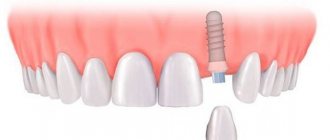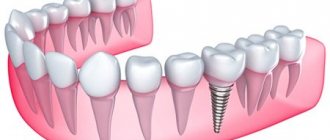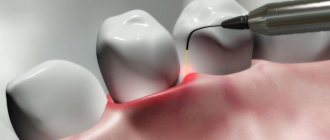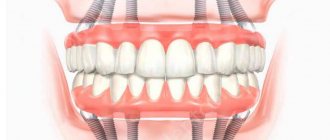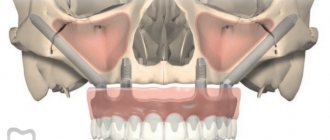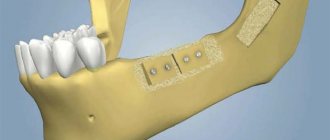Dental implants for missing upper teeth
For front teeth
When choosing implants to replace lost teeth in the anterior region, the following are used:
- Plate structures are produced in the form of a plate on which a rod is fixed. Due to the porous structure of the plate, bone tissue gradually fills the inside of the implant. This provides the artificial tooth with stability and correct position.
- Mini-implants are small titanium rods characterized by atraumatic installation. The advantage is that there are no requirements for bone condition.
- Root-shaped - indicated when there is sufficient bone volume, made of medical titanium. In terms of aesthetics, they are inferior to the first two models. It is better to place zirconium dioxide implants on the front teeth.
Implantation of upper teeth using mini-implants
Artificial roots for the restoration of front teeth should:
- biocompatible with human tissues;
- thin and elongated;
- have a thread with sparse turns at the bottom of the rod and frequent at the top.
To restore aesthetics, zirconium dioxide rods are mainly used, which do not show through the gums after installation.
For chewing teeth
Root type implants
Root type implants are suitable. Titanium rods in the shape of a cylinder with threads provide stability in the bone and resistance to any load. If there is insufficient bone volume, a sinus lift is first performed before installing the system.
There are also subperiosteal rods that are inserted from the side under the gum. They are not used often, mainly in older people in cases of decreased height of the alveolar process due to age-related changes.
Implantation methods for complete and partial edentia of the upper jaw
Implantation is indicated for single defects in the dentition, the absence of several teeth in a row and complete edentia. On the upper jaw, surgery is more difficult to perform due to anatomical and functional features. The jaw bones of the upper dentition are motionlessly connected to the bones of the skull. Plus, in the immediate vicinity of the apexes of the roots of 6-8 teeth, the bottom of the maxillary sinus and the infraorbital nerve pass.
How to do it using the two-stage classical method
- The patient is given a local anesthetic.
- Antiseptic treatment of the oral cavity is performed.
- The gum is incised and the mucoperiosteal flap is removed.
- A hole is prepared in the bone for the implant.
- The titanium rod is screwed in.
- A cover screw is installed.
- The mucoperiosteal flap is returned to its place.
- The gum is sutured.
Process of two-stage classical technique
The period of osseointegration lasts 3-6 months. After healing is completed, a gum former is placed in place of the plug screw, which is replaced by an abutment after a week or two. The latter is covered on top with a crown.
Single-stage installation with tooth extraction and immediate loading
One-stage implantation involves accelerated prosthetics - immediately after implantation of the titanium rod, a temporary crown or prosthesis is installed. This method is often used immediately after tooth extraction. In total, the patient will have to visit the doctor 3 times. During this time the following are performed:
- Diagnostics, impression taking.
- Implantation of an implant, installation of an abutment and temporary crown.
- Replacing a temporary crown with a permanent one.
The express technique is the most gentle and psychologically comfortable implantation option for the patient. The period of osseointegration ranges from 2 to 4 months.
What to do if there is not enough bone tissue to implant implants on top
In case of unsatisfactory condition of the bone structures of the upper jaw, a sinus lift procedure (building up the bone to the required volume) is performed before implantation. The essence of the technique lies in raising the bottom of the maxillary sinus and filling the resulting space with biomaterial. The operation can be performed in two ways:
- open;
- closed.
Open includes several stages:
- Gum section.
- Cutting the outer layer of bone using a ball-shaped bur.
- Providing access to the maxillary cavity.
- Gently lifting the bottom of the maxillary sinus.
- Placement of bone material into the resulting space.
- Installation of a protective membrane.
- Stitching.
Open sinus lift procedure
It takes 5-6 months for the graft to engraft. When the planted biomaterial grows with blood vessels and becomes viable, an implant is implanted into it.
The closed sinus lift technique is indicated for alveolar ridge heights of 7-8 mm. All procedures are performed through a puncture, not a cut. Bone granules are inserted through a miniature hole. The implant is placed immediately after the procedure is completed.
How many implants are needed to restore upper jaw teeth?
If several teeth are missing in a row
If several upper teeth in a row are missing, implants are installed in one of two ways:
- One titanium rod with a crown to replace each lost unit.
- Fixation of a fixed bridge prosthesis with a smaller number of implants. That is, if four teeth are missing, you need to implant two or three rods that will hold the prosthesis.
The operation is performed using classical and express methods. The first provides a delayed aesthetic and functional result. The permanent prosthesis is put on only after the osseointegration process is completed. The second allows you to quickly restore the functions of the dentition, but the aesthetics are not always at a satisfactory level. The doctor decides together with the patient what is best to do in each specific situation, taking into account the latter’s wishes.
If all upper teeth are missing
The problem of absolute adentia is solved in several ways:
- Implantation based on the principle of “one implant for each missing unit.”
- If there is severe bone atrophy, a removable bridge is attached to a minimum number of titanium rods or mini-implants.
- In such situations, the most popular concepts are “All-on-4” and “All-on-6”, which are based on the installation of a permanent bridge structure on 4 or 6 artificial roots using a special technique.
Full implantation
A surgical procedure in which one implant (14 or 12 pieces) is placed for each empty space in the top row. The number of crowns will be equal to the number of implanted rods. For this method of implantation there must be sufficient bone volume. If there is atrophy, bone grafting is performed first. Also, certain difficulties are created by nearby nerves.
Full implantation is the most expensive dental surgery.
Removable denture with a minimum number of implants
There are clinical cases when, in conditions of complete edentia of the upper jaw, it is not possible to place even 4 implants. Then two or three rods are implanted. Abutments with a ball-shaped head are fixed on them, to which a removable bridge-like structure is attached. The beam method of fastening the structure is also used. It creates reliable support and ensures proper distribution of the chewing load.
Implantation on 4 or 6 supports in the absence of teeth in the upper jaw
Installation of a fixed bridge structure on 6 implants
Recently, when the upper dentition is completely edentulous, the “All-on-4” and “All-on-6” implantation concepts are widely used. Their essence is to install a fixed bridge prosthesis on 4 or 6 rods. The advantage of the methods is the instant aesthetic result. The patient goes home with new teeth on the day of surgery.
The implantation process includes:
- Implantation of four implants into the jaw according to the scheme - two in front, two in back (the outer ones are screwed in at an angle of 35-45 degrees). If the All-on-6 protocol is used, one more is placed between them.
- Installation of a temporary prosthesis (consists of 10-12 artificial teeth).
- Fixation of a permanent prosthesis (after 3-6 months). It is made of metal-ceramics, metal-plastic, metal-free ceramics or zirconium dioxide.
Classic two-stage implantation
The standard dental implantation technique includes two stages. First, an implant is implanted into the patient's jawbone. Over the course of several months, it takes root and fuses with the bone. This is called osseointegration. After this period, the patient comes back to the clinic and a prosthesis is installed on the implant that has already taken root.
Thus, the treatment takes place in two stages - implantation and installation of a prosthesis. This technique has been successfully used for almost 50 years.
Classic two-stage implantation is an effective method of tooth restoration. However, its disadvantages are very long treatment times and high cost.
It often happens that before implantation the patient needs to undergo another operation - bone grafting. The fact is that the jawbone tends to decrease as soon as a person loses a tooth.
In patients who restore teeth not immediately after their loss, but after a long period of time, the bone volume is not enough to install an implant. Bone restoration is carried out using bone augmentation.
After the operation, 3 to 4 months should pass and only after that you can begin installing the implant.
Previously, complete adentia could only be cured using classic two-stage implantation. However, this procedure is complex and requires a lot of money, so it is rarely used in cases of complete absence of teeth. The reasons for this are as follows:
- If a person wears removable dentures for a long time, his jawbone loses its volume. To install an implant, you must first restore the original volume of bone tissue. Bone restoration surgery is expensive and requires a fairly long rehabilitation period, during which the patient, again, has to wear removable dentures
- The operation to install implants is quite traumatic, so the rehabilitation period takes several months. Therefore, implantation of a large number of teeth is carried out in several stages
- Installing implants is very expensive, because in addition to the operation itself, it is necessary to carry out a number of preparatory procedures, each of which costs money
- If the patient has no teeth at all, then it will take a very long time to restore them. Since each stage requires a long rehabilitation period, treatment can take about a year and a half
Many patients are interested in the cost of bone grafting. Prices for such an operation start from 15 thousand rubles for one segment, that is, for a part of the bone around one tooth.
How long do implants last?
The issue of the service life of implants worries all patients, because this pleasure is not cheap and you want the structures to last long enough. The service life of titanium roots is affected by:
- Manufacturer's warranty (usually 20-25 years, there are companies that give a lifetime warranty).
- The clinic's warranty on implant installation work is 1-2 years.
The manufacturer undertakes to replace the design in case of defects not related to the actions of the doctor or improper care on the part of the patient. Dentistry undertakes the obligation to reimburse costs if the implant does not take root due to the fault of the specialist.
If the implantation technique and operating rules are followed, implants last about 20 years, and sometimes until the end of the patient’s life.
Possible complications
Any surgical intervention may be accompanied by complications, which manifest themselves in the following:
- mobility or rejection of the product;
- failure of the structure into the maxillary sinus;
- pain syndrome;
- sinusitis or sinusitis;
- bleeding and swelling;
- infection and inflammation;
- postoperative sutures come apart;
- hyperthermia.
To avoid such an unpleasant set of circumstances, be sure to follow all the doctor’s recommendations for oral care and the use of medications to accelerate the healing of damaged tissues and the fusion of the hard tissues of the titanium pin and the bone tissue of the upper jaw.
Average cost in Moscow
For your information, we present the average cost of implantation using different methods in Moscow clinics.
| Name of service | Price in rub. |
| Turnkey implantation of one tooth using a two-stage method | |
| With metal-ceramic crown | 40000 |
| With all-ceramic crown | 50000 |
| With ceramic on special alloy | 60000 |
| One-stage implantation with immediate loading | |
| With installation of a metal-ceramic crown | 58000 |
| Installation of a bridge prosthesis with complete edentia and partial | |
| Partial denture on implants | 70000 |
| Complete denture on mini-implants | 120000 |
| Implantation according to the “All-on-4” protocol | 350000 |
| Implantation according to the “All-on-6” protocol | 400000 |
| Implantation of 14 implants with preliminary bone grafting and further prosthetics | 900000 |
Price
- Primary appointment (examination, consultation) with a dentist (special offer) 100001
For free
Promotion
- Prosthetics of the entire jaw on 4 implants
149 900 ₽
Promotion
- SGS implant + turnkey crown
24 900 ₽
Promotion
- Osstem implant + turnkey zirconium crown
29 900 ₽
Promotion
- Astra Tech implant + turnkey zirconium crown
59 900 ₽
Promotion
- Nobel implant + turnkey zirconium crown
59 900 ₽
Promotion
- Straumann implant + turnkey zirconium crown
59 900 ₽
Promotion
The installation of lower dental implants is preferable to removable dentures from a physiological, aesthetic and functional point of view. Implants allow you to eat any food and enjoy communication without fear of the prosthesis falling out. They transfer the chewing load to the jaw bone, preventing atrophy and facial asymmetry. But implantation requires careful planning due to the anatomy and the close location of the mandibular nerve. The service life of implants is indefinite, while prostheses on them are from 10 years.
